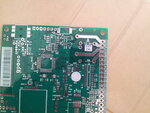T
treez
Guest

Hello,
I have a 1 oz copper PCB, and there is a trace on it which is 2.5cm long and 3mm wide.
...this trace carrys 11 Amps (RMS) of current.
For a 1cm length of this, the trace width goes down to 1.5mm wide.
Is this going to be ok?
It won't mean the PCB trace overheating and getting warped?
....it just seems fantastical that 11 Amps can "squeeze" through a 1.5mm trace neck?
I have a 1 oz copper PCB, and there is a trace on it which is 2.5cm long and 3mm wide.
...this trace carrys 11 Amps (RMS) of current.
For a 1cm length of this, the trace width goes down to 1.5mm wide.
Is this going to be ok?
It won't mean the PCB trace overheating and getting warped?
....it just seems fantastical that 11 Amps can "squeeze" through a 1.5mm trace neck?






